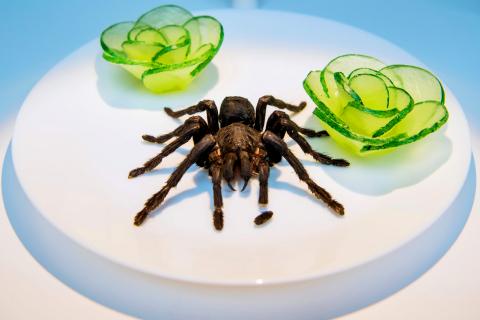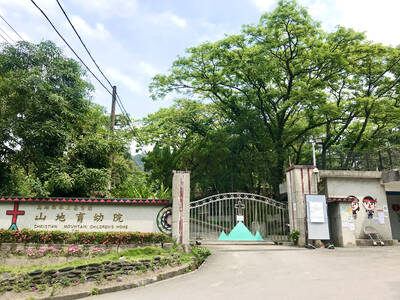Cheese teeming with squirming maggots, sheep’s eye juice and mouse wine: the “Disgusting Food Museum” explores why a dish seems delicious to some, but for others is stomach-churning.
On show for three months at an old slaughterhouse in the southern Swedish city of Malmo, the exhibit — created by Samuel West, who previously served up the Museum of Failure — promises to shock the senses.
“Disgust is always subjective because it comes with what we grew up with. It’s kind of an indoctrination,” says museum director Andreas Ahrens.

Photo: AFP
“If we grew up with something, we don’t find it disgusting,” he says.
To highlight the point, the exhibition puts foods from around the world on an equal footing, so lobster and foie gras are presented in the same way as chewy kiddie sweets and rabbits’ heads.
Gastronomic explorers are warned on entry: the exhibit is not for the squeamish. But, conveniently, the entry ticket is — a sickness bag.
Bag in hand then, visitors venture off on a world tour of specialities, some of which may seem to a Western palate like ingredients in a witch’s brew but are considered delicacies.
“The Disgusting Food Museum exists to let people explore the world of food and to see both their own food and (other food) from the lens of another culture,” says Ahrens.
Its founder “began by thinking of other museums that don’t exist that he would like to visit, and that led to the Disgusting Food Museum,” he adds cheerfully.
CHEESE AND FERMENTED SHARK
“I think it is by far one of the most interesting museums I’ve been to,” says Charlie Lam, a 23-year-old Hong Kong student.
Touring the exhibit with friends, she inspects the 80 dishes on display, cautiously sniffing some, and, when curiosity gets the better of her, tasting a few.
She says she’ll never forget the Su Callu, an ineffable Sardinian cheese served in dried tripe with a lingering aftertaste of ammonia, or the Icelandic delicacy of fermented shark, known as hakarl.
And she finds salty licorice, a hugely popular candy in the Nordic countries, and stinky British and French cheeses as off-putting as some of the non-Western foods are to European tastes.
TOUCHY-FEELY
Many of the dishes are freshly prepared and visitors are encouraged to poke and prod some of them, and of course have a taste — museum staff make sure nobody leaves without trying at least one item.
The bull’s penis — an aphrodisiac in China — is a hard one to resist for many curious onlookers.
“If it would be just fake food, or just plastic or things in a can, it wouldn’t be as interesting. It wouldn’t be as fun,” says Ahrens, who happily guides people through the tables of food.
“So it’s an important part of the experience for the guest.”
Some dishes are displayed on a video screen, such as the cobra’s beating heart, which in Vietnam is savored together with its blood.
“That’s really what I found most surprising,” admits Adam Eliasson, a 24-year-old factory worker.
“Normally I’m a pretty picky eater,” he muses. “I eat very few things... but here I tasted everything. And I didn’t throw up!”
Some dishes however, such as the tortoise soup and bat soup, the sheep’s head stew and baby mouse wine remain off limits to even the bravest of visitors.
The food that is fresh, such as the cheese, is kept in the fridge for three or four days before being thrown out.
Once the exhibit ends on Jan. 27 in Sweden, Ahrens and West hope to take the show on the road to other cities in Europe and around the world.

May 18 to May 24 Pastor Yang Hsu’s (楊煦) congregation was shocked upon seeing the land he chose to build his orphanage. It was surrounded by mountains on three sides, and the only way to access it was to cross a river by foot. The soil was poor due to runoff, and large rocks strewn across the plot prevented much from growing. In addition, there was no running water or electricity. But it was all Yang could afford. He and his Indigenous Atayal wife Lin Feng-ying (林鳳英) had already been caring for 24 orphans in their home, and they were in

On May 2, Chinese Nationalist Party (KMT) Chairman Eric Chu (朱立倫), at a meeting in support of Taipei city councilors at party headquarters, compared President William Lai (賴清德) to Hitler. Chu claimed that unlike any other democracy worldwide in history, no other leader was rooting out opposing parties like Lai and the Democratic Progressive Party (DPP). That his statements are wildly inaccurate was not the point. It was a rallying cry, not a history lesson. This was intentional to provoke the international diplomatic community into a response, which was promptly provided. Both the German and Israeli offices issued statements on Facebook

Even by the standards of Ukraine’s International Legion, which comprises volunteers from over 55 countries, Han has an unusual backstory. Born in Taichung, he grew up in Costa Rica — then one of Taiwan’s diplomatic allies — where a relative worked for the embassy. After attending an American international high school in San Jose, Costa Rica’s capital, Han — who prefers to use only his given name for OPSEC (operations security) reasons — moved to the US in his teens. He attended Penn State University before returning to Taiwan to work in the semiconductor industry in Kaohsiung, where he

President William Lai (賴清德) yesterday delivered an address marking the first anniversary of his presidency. In the speech, Lai affirmed Taiwan’s global role in technology, trade and security. He announced economic and national security initiatives, and emphasized democratic values and cross-party cooperation. The following is the full text of his speech: Yesterday, outside of Beida Elementary School in New Taipei City’s Sanxia District (三峽), there was a major traffic accident that, sadly, claimed several lives and resulted in multiple injuries. The Executive Yuan immediately formed a task force, and last night I personally visited the victims in hospital. Central government agencies and the